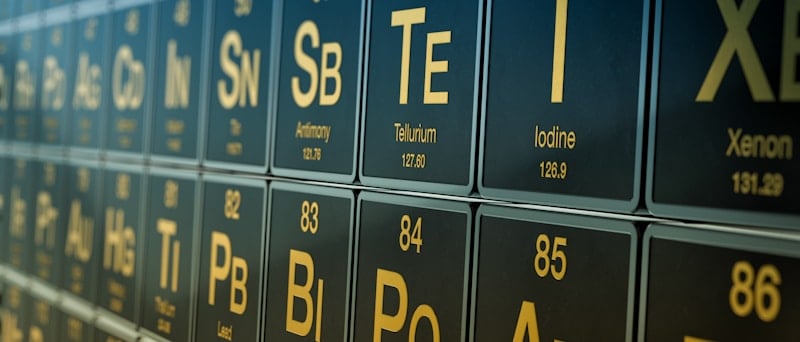Are elements common nouns or proper nouns? This question is probably the best place to start, as it will help us dictate the grammatical rules they fall on. First, we’ll have to break down their differences and their multiple applications when including them in a sentence.
Elements are common nouns, and as such, they are a broad vocabulary for a place, a class of things, a person, and they differ from proper nouns in that it is not required to capitalize them unless they appear on a title or the beginning of a sentence. Come along as we begin tackling this elementary subject.
It does seem uncomplicated, but it can become more complex as you start including chemical compounds and chemical symbols into the equation. As things usually are with chemistry, there are formulas to follow, and changing a single factor will change the entire outcome. So, consequently, capitalization has some of the most dramatic effects on these cases.

What Is A Chemical Nomenclature?
To begin defining what a chemical name is and the bracket it belongs to, we must go back to the source, and that would be the International Union Of Pure and Applied Chemistry (IUPAC). They are the worldwide authority on chemical nomenclature, and they develop and create all the names for chemical compounds while aiming to guarantee that there is no vagueness when writing or speaking of any individual compound. Chemistry is a lot like math in that it demands to be precise.
The IUPAC has published three books elaborating on the rules for naming organic and inorganic compounds. These books are so instrumental to the scientific community that they have been bestowed colors as names such as the Green Book, Blue Book, and Red Book. It is ironic that for an organization so focused on naming things, they have chosen this, perhaps uninspired denominations but make no mistake. These books are paramount and nothing less than the rule of law when addressing chemistry and its physical qualities and symbols.
This series of books establish that a chemical compound’s nomenclature must carry facts about the structure of the compound being named and that a common noun will frequently be sufficient to point out a chemical compound is a particular set of circumstances.
What Is A Chemical Or Element Symbol?
Chemical symbols are abbreviations put in place to cite a specific element and, for the most part, are composed of one or two letters. More often than not, they tend to be the first two letters of their chemical nomenclature. In the instances that this is not the case, it is largely because these same letters have been allocated to another element’s symbol.
There are also selective elements such as gold and silver, whose respective symbols would be AU and AG, which derive from the Latin words coined for them at the time of their discovery. AU meaning Aurum, which meant ”yellow”, and Argentum, which means ”shining metal”.
We predominantly recall with ease the ones with their first letters used in their symbols, such as He for helium or H for hydrogen. That comes as no surprise given how effortless it is to associate these two letters to that particular element with the first two initial letters within their name.
Then, the other elements include two of the letters that compose the chemical nomenclature, but they are not the initial letters. Examples of these particular elements are arsenic, whose symbol is As. If you are wondering why it is not Ar, that symbol already went to argon, another component of the periodic table of elements. This accommodation is probably a result of when and where the element was discovered originally. Consequently, these mild adjustments had to be made to warrant no obscurity when looking to allude to a specific element. Again, chemistry is very much like math, and there is no wanted margin of error on exact sciences.
What Is A Common Noun?
Now that we have addressed these nomenclatures a little bit let us dive deeper into the grammatical side by talking about nouns, common nouns.
Nouns are all about specification, and common nouns refer to the same things as proper nouns because they can encompass people, places, animals, items, and ideas. For example, words like mother, city, pencil, tiger, and pride are all common nouns, and they are never capitalized. Still, you would be fooling yourself to think that you’ve never seen capitalized versions of these words in a book or even your daily newspaper.
It is all about context, and common nouns are only to be capitalized when they are part of a title or are the first word of the sentence. To further elaborate, let’s take the words ”assassin’s cloak”. They are common nouns, but if we were to use them as the title of our hypothetical best-selling novel, we could quickly get away with capitalizing these words and stylizing them as ”Assasin’s Cloak”.
In the same way, we would also need to capitalize the first letter of either word if they were to be the opening word in a sentence. For example, ”Assasins are always stealth,” or ”Cloaks are heavy-duty outfits”.
What Is A Proper Noun?
Having touched base on common nouns, let’s move onto proper nouns. The great differentiator between these nouns is that while proper nouns refer to the same things common nouns do, they always cite a particular entity, person, place, thing, animal, and idea by name. The quickest example of this is our own given names, such as John or places like Denver. They are a particular person’s name and a very specific place, respectively, and therefore we must capitalize these words when used in this context at all times.
Another great example is the words ”main” and ”street” which can be easily categorized as common nouns and, subsequently, not-capitalized terms. Still, if we were to write down an address such as ”8598 Main Street,” it would be mandatory for us to capitalize on these otherwise common nouns because they are citing a very specific place. Like we stated before, nouns are all about specification and context.
So, When Do We Capitalize Elements?
So, now that we’ve amassed a fair amount of context on grammar, we can go back to the matter at hand. Elements are common nouns; hence they are not to be capitalized unless used in a title or at the beginning of a sentence, but this is not the case for their respective symbolic nomenclature. A great example of this would be dihydrogen monoxide, also known as water or H2O. Did you notice how I capitalized the symbolic H2O? It was not by choice, but it is a rule that must be followed when referring to a specific chemical compound such as water.
I can write sodium hydroxide into this sentence as a common noun, but if I were to switch onto the symbolic nomenclature for the chemical compound, I would have to treat it as a proper noun and write it as NaOH.
”Sodium hydroxide can cause bad chemical burns, so you should grab this book called Sodium Hydroxide Remedies for Dummies by the bookshelf over there to alleviate that while I add the rest of this NaOH into the test tube”.
See how you can have fun with it once you get this far?
Elements are ever-present in our daily lives even though that is not always clear to us, so we must respect not only their names but the grammar they follow, and who knows? Maybe now you’ve caught the bug to learn more about the elements around, and you will be able to properly position them on paper the next time you must, even if it’s not for school.
Shawn Manaher is the founder and CEO of The Content Authority. He’s one part content manager, one part writing ninja organizer, and two parts leader of top content creators. You don’t even want to know what he calls pancakes.


